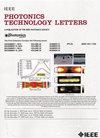Microwave Frequency Divider With Tunable Division Factors Based on an Optoelectronic Oscillator
IF 2.5
3区 工程技术
Q2 ENGINEERING, ELECTRICAL & ELECTRONIC
引用次数: 0
Abstract
A wideband microwave regenerative frequency divider with tunable division factors is proposed and experimentally demonstrated based on harmonic mixing in an optoelectronic oscillator. In the optoelectronic oscillation cavity, a phase modulator is cascaded with an optical filter to achieve equivalent intensity modulation by preserving the single sideband. Harmonic mixing procedure occurs between the基于光电振荡器的可调分频器
提出了一种分频因子可调的宽带微波再生分频器,并进行了实验验证。在光电振荡腔中,相位调制器与光学滤波器级联,通过保留单边带实现等效强度调制。谐波混合过程发生在输入信号的$+ 1^{\ mathm {st}}$阶边带和以下光电探测器内振荡信号的高阶边带之间。当谐波混频过程产生的中频与振荡频率相匹配,且满足环路相位和增益条件时,即可实现微波再生分频。分频因子由谐振混频过程中振荡信号的光边带的阶数决定,并可通过在每条臂上带有移相器的双分接微波滤波器进行调整。实验结果表明,成功实现了工作频率为22 ~ 30 GHz、分频因子为2 ~ 8的微波再生分频器。
本文章由计算机程序翻译,如有差异,请以英文原文为准。
求助全文
约1分钟内获得全文
求助全文
来源期刊

IEEE Photonics Technology Letters
工程技术-工程:电子与电气
CiteScore
5.00
自引率
3.80%
发文量
404
审稿时长
2.0 months
期刊介绍:
IEEE Photonics Technology Letters addresses all aspects of the IEEE Photonics Society Constitutional Field of Interest with emphasis on photonic/lightwave components and applications, laser physics and systems and laser/electro-optics technology. Examples of subject areas for the above areas of concentration are integrated optic and optoelectronic devices, high-power laser arrays (e.g. diode, CO2), free electron lasers, solid, state lasers, laser materials'' interactions and femtosecond laser techniques. The letters journal publishes engineering, applied physics and physics oriented papers. Emphasis is on rapid publication of timely manuscripts. A goal is to provide a focal point of quality engineering-oriented papers in the electro-optics field not found in other rapid-publication journals.
 求助内容:
求助内容: 应助结果提醒方式:
应助结果提醒方式:


